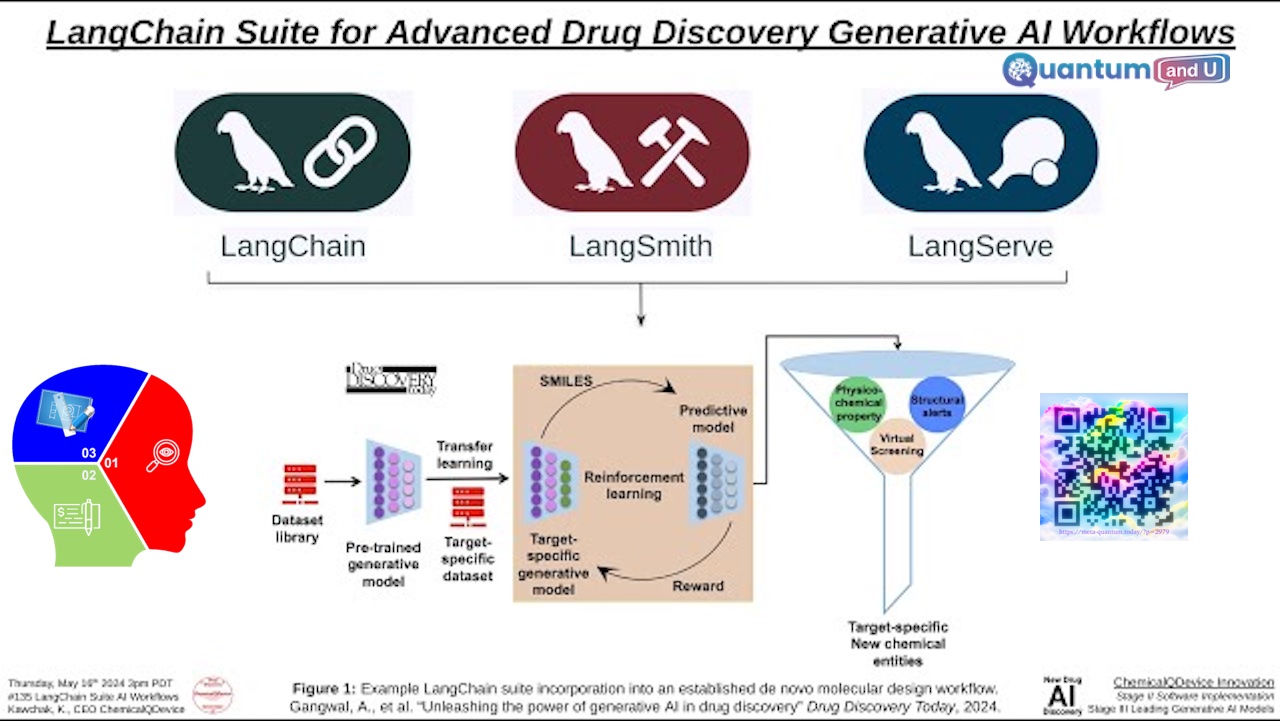
Introduction:
This document reviews the LangChain Suite, a toolkit designed for developing applications with large language models (LLMs) such as the GPT series. It has significantly influenced drug discovery and generative AI workflows.
This review covers the LangChain Suite’s key components: agents, retrieval mechanisms, chains, LangServe, and LangSMITH. Agents are the building blocks of the toolkit, simplifying complex tasks. The retrieval mechanism enhances the output of LLMs by fetching pertinent information. Chains provide efficient sequences, LangServe allows for serving LLMs as APIs using FastAPI, and LangSMITH assists in tracing and visualizing LLM workflows.
The review also includes demonstrations of drug discovery, illustrating the effective use of LLMs in this process through the LangChain Suite.
LangChain Suite in Drug Discovery Workflow:
LangChain Suite is a software platform designed to streamline the use of large language models (LLMs) in the field of drug discovery. Here’s a breakdown of what it offers:
Focus on Generative AI Workflows:
- LangChain Suite facilitates the creation of complex workflows that leverage the capabilities of LLMs.
- These workflows can automate tasks involved in drug discovery, such as molecule design, property prediction, and literature analysis.
Core Technology:
- The foundation of LangChain Suite is LangChain Core, an open-source project.
- It provides an expression language (LC) specifically designed for building LLM-powered workflows.
- LC enables features like parallelization, error handling, and traceability within the workflows.
Modular Design:
- LangChain Suite is built with a modular architecture, allowing for customization based on specific needs. expand_more
- Researchers can leverage their imagination to design workflows that suit their drug discovery endeavors.
Benefits:
- Efficiency: LangChain Suite aims to streamline complex drug discovery workflows that involve LLMs.
- Explainability: The platform is designed to prioritize explainability, allowing researchers to understand the rationale behind the LLM’s outputs and improve their workflows.
- Flexibility: The suite offers a modular design, enabling researchers to customize workflows based on their specific needs.
Related Sections of above video:
LangChain Overview
- LangChain is the #1 developer community for building generative AI apps with LLMs
- Core components: LangChain Expression Language, agents, retrieval, chains, templates
- Supports parallelization, fallbacks, tracing for explainability
- Over 14 million downloads per month
LangChain Suite Components
- Agents: Flexible but less reliable multi-agent collaboration workflows
- Retrieval (RAG): Augmenting LLM outputs by retrieving relevant information
- Chains: Efficient but less flexible predefined sequences
- LangServe: Serving LLMs as API using FastAPI
- LangSMITH: Tracing and visualizing LLM workflows for explainability
Demonstrations
- Code Assistant: Checking and generating code using GPT-4 on an L4 GPU
- Agent Supervisor: Multi-agent workflow with a researcher, coder and supervisor
- Raptor: Clustered retrieval and summarization using documents and an LLM
Key Findings
- Raptor technique was most practical for relevant and concise outputs
- GPT-4 gave more relevant and economical outputs compared to GPT-3.5
- Tracing with LangSMITH aided explainability of LLM workflows
- Some errors persisted even with iterative workflows
Potential Impact of LangChain Suite on Drug Discovery in Southeast Asia:
Positive Impacts:
- Accelerated Drug Discovery: LangChain Suite’s streamlined workflows could significantly speed up the drug discovery process in Southeast Asia. This could lead to faster development of new treatments for diseases prevalent in the region.
- Enhanced Research Capabilities: The suite’s focus on powerful LLMs and explainability could empower researchers in Southeast Asia to conduct more advanced drug discovery research, potentially leading to breakthroughs.
- Increased Collaboration: The modular design might foster collaboration between researchers across Southeast Asia, allowing them to share and customize workflows for specific regional needs.
Opportunities:
- Tropical Disease Research: Southeast Asia faces a unique burden of tropical diseases. LangChain Suite could be a valuable tool to prioritize drug discovery efforts for these diseases.
- Natural Product Exploration: The region boasts a rich biodiversity with potentially undiscovered medicinal properties. LLMs combined with LangChain Suite could accelerate the exploration of these natural products for drug development.
- Addressing Affordability Challenges: Southeast Asia often struggles with high drug costs. LangChain Suite could help identify more affordable treatment options by optimizing drug discovery processes.
Challenges to Consider:
- Accessibility and Infrastructure: The suite might require significant computing resources, potentially limiting accessibility for some research institutions in Southeast Asia.
- Technical Expertise: Researchers in the region would need proper training to effectively utilize LangChain Suite’s advanced LLM functionalities.
- Data Availability: LLMs often require vast amounts of data for training. Ensuring access to high-quality, relevant data for drug discovery projects in Southeast Asia could be crucial.
Conclusion:
The LangChain Suite is a potent toolkit for developers focused on generative AI in advanced drug discovery workflows. Its primary components, Chains, Agents, LangSmith, and LangServe, provide robust solutions for managing AI models efficiently and on a large scale. Although there are challenges with token limits and a steep learning curve, the suite’s broad community support and practical applications make it a significant asset for developers.
LangChain Suite proves to be a beneficial tool for researchers in drug discovery, allowing them to harness the power of LLMs in a structured and efficient way.
Furthermore, the LangChain Suite opens up promising opportunities to propel drug discovery in Southeast Asia. By tackling the challenges and utilizing the suite’s strengths, researchers have the potential to devise new treatments and enhance healthcare outcomes in the region.
Takeaways:
- LangChain provides flexible and powerful abstractions for building generative AI apps with LLMs
- Raptor clustered retrieval was fast, high-performing and promising for drug discovery
- Tracing with LangSMITH enhances explainability of “black box” LLM outputs
- While multi-agent architectures are more flexible, techniques like Raptor are currently more reliable
- Economical to get started, but monitoring API usage and costs is important for larger workloads
- Explainability of LLMs remains a key challenge to be addressed


